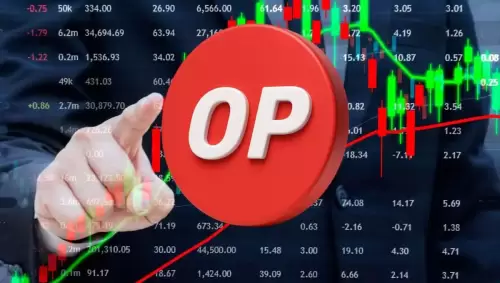 |
|
 |
|
 |
|
 |
|
 |
|
 |
|
 |
|
 |
|
 |
|
 |
|
 |
|
 |
|
 |
|
 |
|
 |
|
Cryptocurrency News Articles
Unpacking the Explosion in Derivative-Backed ETFs
May 20, 2025 at 01:21 am
This article takes a closer look at ETFs that trade options on single stocks to generate exceptionally high yields—among the hottest-selling funds in the market today.

While a significant amount of money continues to flow into low-cost, plain-vanilla ETFs, the ETF universe is becoming increasingly complex. Most new ETFs being launched are actively managed, and many make use of derivatives.
Two recent regulatory changes—the “ETF Rule” and the “Derivatives Rule”—have made it easier for providers to launch ETFs and incorporate derivatives into their strategies. The explosion in derivative-backed ETFs has been particularly striking.
Most of these new derivative-based ETFs fall into one of three categories:
Buffer or defined outcome ETFs
Leveraged or inverse single-stock ETFs
Option-based income ETFs
Some of the newest products even combine options-selling strategies with leveraged single-stock ETFs. (See: Buffer ETFs Attract Billions as Investors Seek Shelter from Market Turmoil)
This article takes a closer look at ETFs that trade options on single stocks to generate exceptionally high yields—among the hottest-selling funds in the market today. Thanks to their eye-catching distribution rates, these funds are generating significant buzz on social media. However, they generally underperform the underlying stocks, even as they continue to attract assets from investors drawn to their lucrative monthly payouts.
We analyzed the performance of 24 single-stock covered call ETFs in the YieldMax suite from their respective inception dates. We focused on YieldMax because it is the clear leader in this niche, significantly ahead of competitors despite a recent surge in similar offerings.
Many of YieldMax’s ETFs launched in 2023—providing a limited, yet more substantial, performance history compared to most rivals, which are even newer.
Despite their eye-popping distribution rates, these products tend to underperform on a total return basis due to steep declines in share price. Of the 24 YieldMax ETFs we examined, only two managed to slightly outperform their respective underlying stocks.
Option Income ETFs: How the Strategy Works
YieldMax currently offers 48 ETFs in U.S. markets, with total assets under management of over $10 billion. Though relatively new—the oldest, TSLY, debuted in November 2022—the suite has grown rapidly, largely driven by its headline-grabbing distribution yields of 100% or more. Inspired by this success, many copycat ETFs have entered the market.
According to the provider, the primary investment objective of these funds is to seek current income; the secondary objective is to seek exposure to the price movement of the underlying stock, subject to a cap.
These funds do not actually hold the underlying stocks. Instead, they gain synthetic exposure by taking long positions in call options and short positions in put options. They also hold Treasury securities for collateral and additional income.
To generate monthly income, the fund manager sells call options against the synthetic long position. These calls typically have expirations of one month or less and strike prices about 0%–15% above the current share price. In some cases, managers use covered call spread strategies to further enhance yields.
The YieldMax Reddit community has around 44,000 members, many of whom discuss using these ETFs to replace their 9-to-5 jobs or to generate retirement income.
The four most popular products in the suite are linked to some of the hottest and most volatile stocks. This inherent volatility leads to higher option premiums—and higher potential income. Each of these ETFs has gathered over $1 billion in AUM.
Yields are calculated by annualizing the most recent monthly payout and dividing it by the fund’s latest NAV. However, yields can vary significantly from month to month as income from selling options depends on fluctuations in the underlying stock, implied volatility, and other factors.
Performance Since Inception
We analyzed the total return—including distributions—of YieldMax ETFs from their inception versus their respective underlying stocks. Some stocks surged, some declined, and others remained relatively flat—but in all cases except those tracking PayPal PYPL and Marathon Digital MARA, the ETF underperformed the stock.
For the four most popular products, the performance gap was substantial—showing that investors may be leaving a lot of money on the table in pursuit of yield.
YieldMax MSTR Option Income Strategy ETF (MSTY)
The most popular product in the suite celebrated its one-year anniversary in February and now boasts $4 billion in assets. It is also the highest-yielding single-stock ETF in the lineup, offering a 136% distribution rate. Since inception, it has delivered a total return of 286%, while MSTR stock has surged 457% during the same period.
Once a little-known, money-losing software firm, Strategy MSTR has become the largest corporate holder of bitcoin and now trades like a leveraged bet on the cryptocurrency. Its stock commands a significant premium over the value of its bitcoin holdings.
Some experts believe the financial engineering behind MSTY—and the premium valuation—may be unsustainable
Disclaimer:info@kdj.com
The information provided is not trading advice. kdj.com does not assume any responsibility for any investments made based on the information provided in this article. Cryptocurrencies are highly volatile and it is highly recommended that you invest with caution after thorough research!
If you believe that the content used on this website infringes your copyright, please contact us immediately (info@kdj.com) and we will delete it promptly.


























































